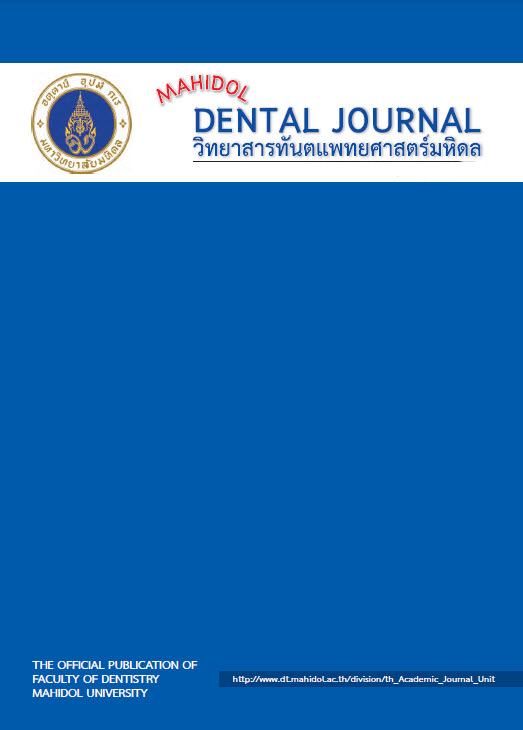Modification of curing technique of a ‘Self Cure’ injection molding acrylic resin: Effect on color stability
Main Article Content
Abstract
Abstract
Objective: To investigate color stability of a heat-cure, a self-cure, and a modified curing self-cure injection-molding denture base materials after immersing in distilled water and coffee for 7 days and 30 days.
Materials and Methods: Three groups of injection-molding denture base materials were fabricated as the disk specimens (diameter 50 mm and thickness 0.5 mm). Heat-cure SR Ivocap® High Impact were wet cured following the manufacturer instruction (100 oC for 35 min - Ivocap wet curing). Self-cure IvoBase® Hybrid were dry cured in an automated instrument, which the curing temperature started from 40 OC up to 120 OC for 35 min (IvoBase dry curing). The IvoBase® Hybrid material were also wet cured at 100 OC for 35 min (IvoBase wet curing). Ten specimens of each group were measured for baseline color (T0) using a spectrophotometer. Five specimens of each group were immersed in distilled water and the other five in coffee. The color values of the specimens were remeasured at the 7th day (T7) and at the 30th day (T30). The mean color differences (∆E) for the experiment groups were compared statistically by using Split-plot ANOVA, followed by Tukey’s honest significant difference (HSD) test at 5% level of significance.
Results: Color differences (∆E) of each experiment group were not significantly different when compared at the same immersion period within the same immersion solution (p>0.05). However, the color differences were significantly different between 7 days and 30 days of immersion for both immersion solution (p<0.05). The color differences were also found between the materials immersed in coffee and distilled water at the same periods of immersion time (p<0.05). Modified curing technique of IvoBase Hybrid material did not cause any significant color changes.
Conclusions: Longer immersion time and different immersion solutions resulted in color changes of Ivocap High Impact and IvoBase Hybrid. Modified curing of IvoBase Hybrid did not result in color changes.
Article Details
References
International Organization for Standardization. ISO 20795-1:2013[E], Dentistry –Base polymers – Part 1. ISO Geneva, Switzerland 2013.
Anusavice K, Shen C, Rawls H. Phillip's Science of Dental Materials. 12th ed. Missouri: Elsevier Inc; 2013.
McCabe J, Watts A. Applied Dental Materials. 9th ed. Oxford: Wiley-Blackwell; 2008.
Powers JM, Sakaguchi RL. Restorative Dental Materials. 12th ed. St. Louis: Mosby Elsevier; 2006.
Powers JM. Dental Materials, Properties and Manipulation. 9th ed. St. Louis: Elsevier; 2008.
Imirzalioglu P, Karacaer O, Burak Y. Color stability of denture acrylic resins and soft lining material against tea, coffee, and nicotine. J Prosthodont. 2010;19:118-24.
Anderson GC, Schulte JK, Arnold TG. Dimensional stability of injection and conventional processing of denture base acrylic resin. J Prosthet Dent. 1988;60:394-398.
SR Ivocap® System Instructions for Use. Liechtenstein: Ivoclar Vivadent AG; 2010.
Scientific Documentation IvoBase®. Liechtenstein: Ivoclar Vivadent AG; 2012.
Hersek N, Canay S, Uzun G, Yildiz F.Color stability of denture base acrylic resins in three food colorants. J Prosthet Dent. 1999;81(4):375-9.
Sepulveda-Navarro WF, Borge CP, Urban VM. Color stability of resins and nylon as denture base material in beverages. J Prosthodont. 2011;20:632-8.
Goiato MC, Nobrega AS, Santos DM, Andreotti AM, Moreno A. Effect of different solutions on color stability of acrylic resin-based denture bases.Braz Oral Res.2014;28;1-6.
Jerolimov V, Jagger RG, Milward PJ. Effect of the curing cycle on acrylic denture base glass transition temperatures. J Dent.1991;19:245-8.
Tandon R, Gupta S, Agarwal SK. Denture base materials: From past to future. Indian J Dent Sci.2010;2:33-9.
May K, Razzoog ME, Koran III A, Robinson E. Denture base resins: comparison study of color stability. J Prosthet Dent 1992;68:78-82.
Bohra PK, Ganesh PR, Reddy MM, Ebenezar AV, Colour stability of heat and cold cure acrylic resins. J Clin Diagn Res 2015;9:12-15.
Buyukyilmaz S, Ruyter IL. Color stability of denture base polymers. Int J Prosthodont.1994;7:372-382.
Hollis S, Eisenbeisz E, Versiuis A. Color stability of denture resins after staining and exposure to cleansing agents. J Prosthet Dent. 2015;114:709-14.
Polyzois GL, Yannikakis SA, Zissis AJ. Color stability of visible light-cured,hard direct denture reliners : an in vitro investigation. Int J Prosthodont. 1999; 12: 140-5.
Paravina RD, Powers JM. Esthetic Color Training in Dentistry. St. Louis; Mosby: 2004.
Lai YL, Lui HF, Lee SY. In vitro color stability, stain resistance, and water sorption of four removable gingival flange materials. J Prosthet Dent. 2003;90:293-300.
Ren J, Lin H, Huang Q, Zheng G. Determining color difference thresholds in denture base acrylic resin. J Prosthet Dent. 2015 ;114:702-8.
Ren J, Lin H, Huang Q, Zheng G. Determining color difference thresholds in denture base acrylic resin. Biomed Mater Eng. 2015;26:35-43.
Khashayar G, Bain PA, Salari S, Dozic A, Kleverlaan CJ, Feilzer AJ. Perceptibility and acceptability thresholds for colour differences in dentistry. J Dent. 2014;42:637-44.
Johnston WM, Kao EC. Assessment of appearance match by visual observation and clinical colorimetry. J Dent Res.1989; 68:891-22.

